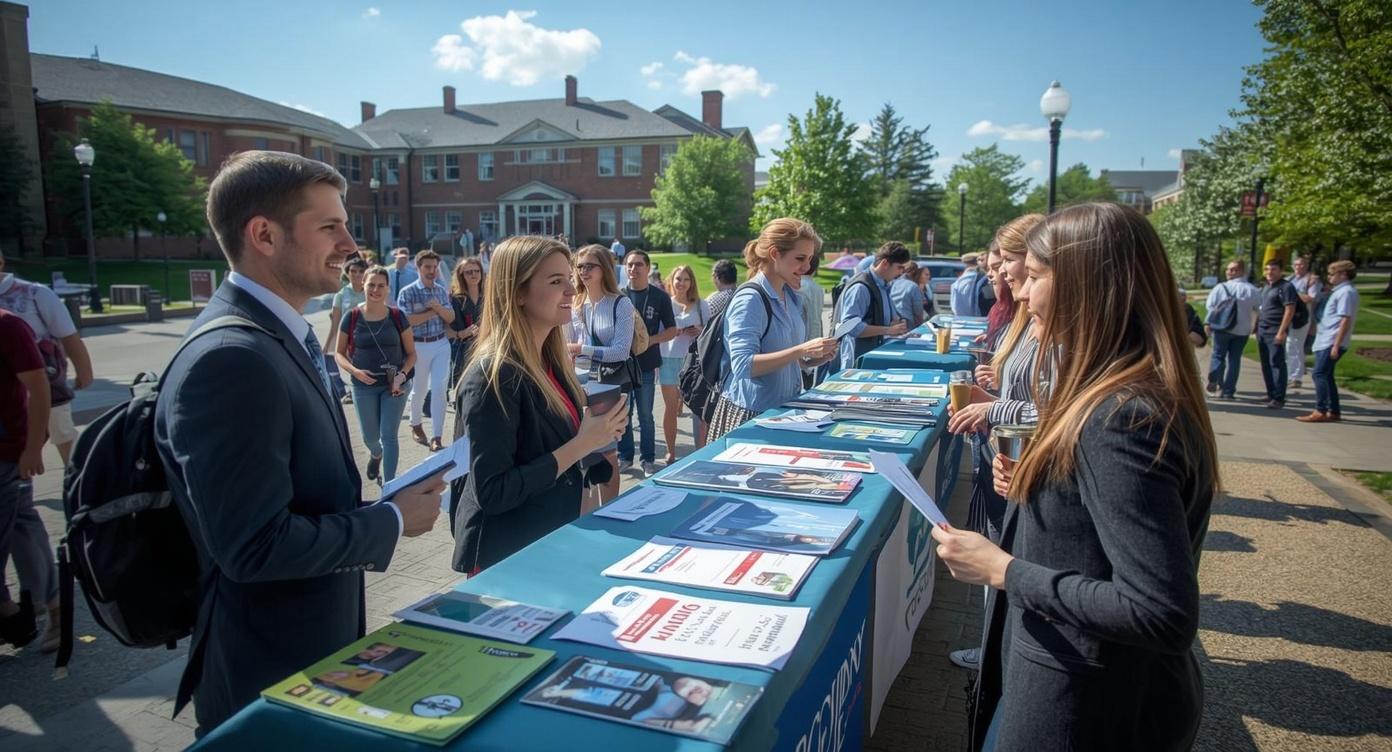One of the most enjoyable parts of my career was spent leading university recruiting programs for a global health care company. What I didn’t realize before moving into that role was that recruiting early talent is totally different than experience hire recruiting. I’ve been blessed to leverage that experience advising clients on early talent recruiting strategy and still get enjoyment out of scaling university recruiting programs for clients in many industries. I’ve seen programs that consistently deliver exceptional talent, and I’ve witnessed others that burn through six-figure budgets with little to show for it. The difference isn’t the employer brand or the compensation package, it’s the fundamentals.
Here’s what actually works when building a university recruiting program that drives results.
✴ Start with Strategy, Not Events
Most companies approach university recruiting backwards. They book career fair booths, sponsor hackathons, and host info sessions without first defining what success looks like. The result? Random acts of recruiting that feel busy but deliver inconsistent results.
Before you send a single recruiter to campus, answer these questions: What roles are you hiring for? How many positions? What skills are truly required versus nice-to-have? Which universities have programs aligned with your needs? What’s your realistic conversion rate from first touch to offer acceptance?
I worked with a mid-sized fintech company that was recruiting at 25 universities with a team of three recruiters. They were exhausted and under-delivering. We cut it down to eight target schools where their technical needs and culture actually aligned with the student population. Their offer acceptance rate jumped from 42% to 71% in one cycle.
✴ Build Relationships, Not Transactions
The companies that win at university recruiting think in years, not quarters. They build genuine relationships with career services offices, faculty, student organizations, and alumni networks. These relationships create a pipeline that keeps flowing even when you’re not actively hiring. Note that this strategy works for companies of all sizes. I’ve applied it from companies whose intern hiring was 15 and another who hired thousands.
I learned this lesson early in my career when a career services director called me directly about a student she thought would be perfect for our team. We weren’t actively recruiting at that school that semester, but we made an exception. That candidate became one of our top performers and eventually a hiring manager herself. That only happened because we’d invested two years in building trust with that career center. The reason this strategy worked was because the investment was time, not money. Career Services knew who I was and what kinds of talent my company was looking for. I met professors to talk about curriculum. I had yearly meetings with deans of the schools we recruited from.
Practical steps: Assign a dedicated point person for each target school. Have them connect quarterly with career services, not just during recruiting season. Offer to guest lecture, mentor students, or participate in curriculum advisory boards. Show up when you’re not hiring. Later in my career I applied this strategy while working at a 500 employee company and was happy to see it be just as successful. Schools want companies to hire their students. Big or small doesn’t matter to them.

✴ Design for the Student Experience
Students are evaluating dozens of employers while juggling classes, exams, and part-time jobs. If your process is clunky, slow, or opaque, you’ve already lost them to a competitor.
Your university recruiting process should be the smoothest experience you offer. Respond to applications within five business days. Schedule interviews within two weeks of application. Make your timeline crystal clear. If a student is moving forward, tell them what happens next and when. If they’re not, tell them quickly and respectfully.
I recently advised a company that was losing finalists to competing offers. The issue wasn’t compensation—it was their six-week gap between final interviews and offers. Students were accepting other offers in that window. We compressed their decision-making timeline to ten days, and their yield rate improved by 28%. I’ve seen this in my life as well. My son entered his senior year of college this past August. He met a company on campus in September and accepted an offer of employment in early October. He starts next August. In university recruiting, the early bird gets the best worms!
✴ Involve Your Best People, Not Just Your Available People
Who represents your company on campus matters enormously. The recruiters and employees you send should be excellent ambassadors: articulate about the work, honest about challenges, and genuinely enthusiastic about the company. They should also reflect the diversity of your workforce and the roles you’re hiring for.
One mistake I see repeatedly: companies send whoever is available rather than whoever is best. A disengaged engineer who treats campus visits like a chore will cost you candidates. A passionate mid-level employee who loves what they do will attract talent. It’s great to send alumni back to their universities but don’t make that the only criteria. Make sure they are passionate about your company and is up for the work at hand, not just reliving memories of their college years.
Having campus ambassadors, who create interest prior to campus presentations, pass out swag to promote the company, and generally keep a company presence throughout the year, are a low-cost investment with potential for high impact. Create a campus ambassador program with clear expectations, training, and recognition. Make it prestigious. Rotate your ambassadors so students see different faces and perspectives. And always, always prepare them with talking points about current projects, growth opportunities, and what makes your culture unique. If you are a smaller company that does not have past interns at all the campuses where you are interviewing, work with career services to identify exceptional students you can train to understand what it’s like to work at your company.

✴ Create Meaningful Touchpoints
Career fair booths with branded swag and a fishbowl raffle aren’t meaningful touchpoints. They’re noise. Students forget you the moment they walk away.
Meaningful touchpoints create value for students and showcase your company’s expertise. Technical workshops where your engineers teach something useful. Case competitions that simulate real work. Coffee chats where students can ask unfiltered questions about career paths. Day-in-the-life job shadows that show, not tell, what the work actually involves.
One of the most effective programs I built was a semester-long mentorship initiative where our employees mentored college juniors. It required minimal time commitment—one hour monthly—but it built deep relationships. When those juniors became seniors, they recruited their peers to apply. We went from 15 applications per year from that school to over 200.
✴ Measure What Matters
If you’re not tracking metrics, you’re not improving. But track the right metrics. Application volume is a vanity metric. Quality of hire, offer acceptance rate, first-year retention, and time-to-productivity matter far more.
Build a dashboard that tracks: source of hire by university, conversion rates at each stage, offer acceptance rates, time-to-fill, first-year performance ratings, and retention through year three. Use this data to identify which schools, which events, and which relationship-building activities actually drive results.
I worked with a company that discovered through data analysis that their most successful hires came from one specific student organization at three universities, not from career fairs. They reallocated budget accordingly and saw quality of hire improve significantly. This work can also lead to a reduction in the number of campuses you recruit from to get the same number of hires, increasing value while driving down cost per hire.
✴ Invest in Your Intern and Co-op Programs
Your intern and co-op programs are your most powerful university recruiting tools. They’re 10-week to 6-month working interviews that let both sides evaluate fit. Done well, they’re your primary pipeline for full-time hires.
Yet many companies treat internships as an afterthought. Interns get assigned busywork, have managers who are too busy to mentor them, and leave with a mediocre impression of the company.
Treat interns like the future full-time employees they could become. Assign them real projects with clear deliverables. Pair them with mentors who actually have time to invest. Create a structured program with learning opportunities, networking events, and executive exposure. Measure intern-to-full-time conversion rates and hold managers accountable.
I built a university program from scratch which was hugely successful. We treated our 12-week internship like a comprehensive onboarding program, complete with technical training, professional development, and a final presentation to senior leadership. Interns told their friends. Their friends applied. The flywheel started spinning. We weren’t a company that could offer all of our interns a full-time role but we were clear with the students what roles had the potential and which didn’t. And we treated all of them like future employees which led to the success of the program.
The Bottom Line
Building a university recruiting program that actually works requires strategic focus, relationship investment, and operational excellence. It’s not about being everywhere or having the biggest booth or the most swag.
It’s about being intentional with your target schools, building authentic relationships over time, designing for the candidate experience, sending your best people, creating real value for students, measuring what matters, and treating interns like the strategic priority they are.
Do these things consistently, and you’ll build a program that doesn’t just fill requisitions—it becomes a sustainable competitive advantage for your organization.
Need help creating a viable university recruiting program or re-energizing your current efforts? Reach out to ES Talent Solutions (info@estalentsolutions.com) for more information. Conversations are free and results are game-changing!
ES Talent Solutions is proud of the work we do to assist clients in building and implementing effective early talent sourcing strategies. Want to understand how these activities could improve recruitment at your company? Contact Eddie Stewart at estewart@ESTalentSolutions.com today! I always enjoy talking with fellow recruiting leaders about what’s working and what challenges you’re facing.





0 Comments
Candidate Sourcing in 2025: Beyond LinkedIn and Job Boards
Sourcing talent is evolving rapidly. If you're solely relying on the same methods you were two years ago, it's time to make a change.
The Talent Edge Newsletter – Technology that Transforms Recruiting
This monthly newsletter covers all things technology this month, including ATS selection, vendor assessment tools, and more.
ATS Selection Guide: 15 Questions Every Recruiting Leader Should Ask
Implementing a new ATS can be a costly venture. Know what to look for and what criteria are important to make your investment a great one.